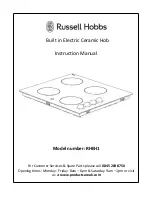
18
EKE 61.0
Electrical connection
■
The built-in cooking area must be connected to the mains supply by
a qualified electrician who is authorized to carry out such work.
■
Both legal wiring regulations and the requirements of your local electricity
supply board must be fully complied with.
■
When connecting the hob, a device must be provided which enables all-
pole disconnection of the hob from the supply with a gap construction of at
least 3 mm. Circuit breakers, fuses and contactors are considered to be
suitable disconnecting units.
■
When connecting and repairing the appliance disconnect it from the elec-
tricity supply with one of these devices.
■
Overall protection against electric shock must be ensured by the installation.
■
The earthed conductor lead must be sufficiently long so that, in the event
of failure of the strain relief, it is not subjected to strain until after the live
wires of the connection cable.
■
Any superfluous cable must be removed from the installation area beneath
the appliance. See the illustration on page 16 for the position of the cable
cut-out.
To connect the appliance, unscrew the switchbox cover on the underside of
the appliance to access the terminal block. After connecting the appliance, re-
place the cover and secure the connection cable with the strain relief clamp.
■
The green-yellow earth conductor must be longer than the other wires.
Electrical connections
Caution:
Incorrect connection results in the total destruction of the power elec-
tronics.
Electrical
connection
Permanent connection by means of an oven connection
socket.
Connection
diagram
is depicted on the underside of the appliance, suitable for
the various types of mains.
Connection data
Permanent connection 400 V 3 N
~
50 Hz
(AC 230 V in UK)
Voltage of heating element: 230 V
Total connection output: 7.0 kW
400 V 3 N
~
safety current 16 A
400 V 2 N
~
safety current 20 A
230 V 1 N
~
safety current 25 A
Connection cable at least of type HO5 VVF
Length of cable as necessary.
(*) This type of electrical connection is not permitted by the SEV (Swiss As-
sociation of Electrical Engineers) in Switzerland.



























